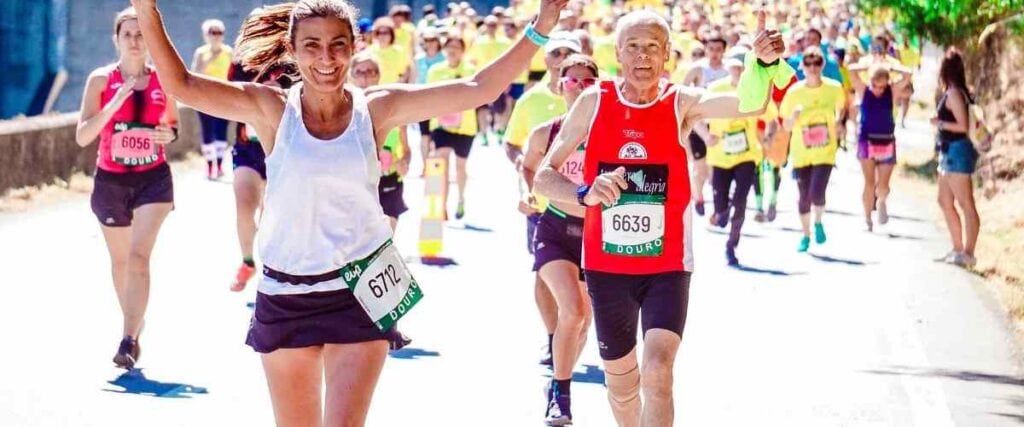
How to Run Smarter and Faster With Negative Splits
After entering the world of competitive running, you’ll soon discover many strategies for maximizing your speed, energy, and pacing during races. Running negative splits is just one of the many strategies experienced and professional runners use to run smarter and faster. Employing the same strategy with your own running may help you achieve the same goals.
What is a negative split?

The term “negative split” refers to how you pace a race or set running distance.
- A negative split means you run the race’s second half faster than the first half.
- A positive split means running the second half of a race slower than the first.
- An even split means you run both halves of the race at the same pace.
Negative splitting is a strategy runners have been using since the early 20th century, and many Olympic swimmers also use the same approach to their races.
You don’t have to be a professional athlete to run negative splits; anyone can do them. However, most people don’t. They’re not necessary for a race, and you can always try your best to hold out until the bitter end, but there are plenty of great benefits of running negative splits while racing or training!
The best way to find out which pacing strategy is right for you is just to try them out and experiment.
Are negative splits good?

Negative splits aren’t inherently good or bad, but most people in the running community feel that they are good because they teach you how to pace yourself properly throughout a race. Managing your energy when you run long distances can be very helpful to avoid losing steam at the very end of a race, especially if you tend to give it your everything at the beginning of a run and run out of steam by the end.
Experienced and professional runners often employ the pacing tactic of negative splits, but your average, everyday runner doesn’t necessarily need to be doing them all the time. If you choose to run negative splits, however, they’ll help you learn how to manage your speed and energy in races, but you don’t need to run negative splits every race. You know what they say…too much of a good thing can be more harmful than helpful.
Can I run a negative split with any distance?

Yes, technically, you can run a negative split with any distance. However, negative splits will likely be more helpful when running longer distances, such as half marathons or marathons.
That’s because when running a shorter distance, you’re more likely to be able to start fast, hang on, and make it to the end of the race while maintaining a relatively quick speed. Regardless, a negative split can be effective with any distance, whether running a 5K, 10K, or a marathon.
On the same note, certain situations may not be ideal for negative splits. For instance, if you’re running a race where the route terrain is more hilly in the second half, it may not be the best choice (or even possible).
What are the benefits of running negative splits in my races?

Running negative splits has many benefits for novice and experienced runners alike:
- It builds discipline: Most runners have an instinct to start running as fast as possible. However, running negative splits requires you to slow down and practice self-restraint intentionally. Although you may knowingly allow other runners to pass you by, you can practice building discipline by conserving your energy and passing them later in the race.
- It enables you to set effective goals during races: As you gradually increase your speed throughout a race, you can focus on passing the next runner ahead, one at a time. This type of goal-setting often feels more manageable and achievable, which can positively affect your mental state throughout the race.
- It helps you learn how to manage your energy: Excess lactic acid buildup can cause you to slow down substantially toward the end of a race. However, starting slowly allows your body to compensate for all the lactic acid it’s producing and the low oxygen levels that occur during high-intensity exercise activities, like running.
- It builds confidence: As you practice running negative splits, you’ll gain more confidence in your ability as a runner. Instead of feeling out of control when running, you’ll feel more in control of your physical state and better manage the process.
How to run negative splits to get faster

Before attempting to run a negative split in any race, it’s essential to spend some time training. That way, you can feel completely confident and in control of your pacing strategy throughout the race. Here are some of the best ways to train for negative splits, whether you’re running indoors with Vingo or outdoors on the pavement.
Progression runs
As the name implies, this process involves gradually increasing your pace during a run. Start with a gentle warmup, progress through faster paces each half mile or mile you run, and then end with a cooldown.
Long runs
Intentionally schedule a long run into your weekly routine and practice your negative splits with each one. For example, if you’re going on a ten-mile run, begin your run in Zone 1 (the most effortless pace). Then, pick up the pace slightly during miles two through five. Increase your speed further during miles six through ten. Instead of running as fast as you can, focus on controlling your speed. The more you practice controlling your pace, the easier it will become.
Interval training
Interval runs are short and fast runs with easy to slow recovery intervals in between, repeated several times. To train for negative splits, simply start your intervals at a much slower pace than you usually would and gradually increase the speed as you go.
Helpful tips for running negative splits

If you’re new to negative splits (or running in general), it can be difficult to pace yourself. However, with time and practice, you can learn how to control your pacing and run faster overall race times. Here are some tips that may help:
- Start slow: If you want to finish a race faster, you’ll need to start the event running slower. Try not to get caught up in the excitement of taking off as fast as you can right at the beginning. Remember that you’ll need to conserve energy to sustain yourself through the final miles of your race.
- Gradually build speed: Every few miles, pick up the pace and keep it steady. As you train for your race, you’ll start to gain a better understanding of the speeds you can comfortably achieve and sustain while racing.
- Listen to your body: Be willing to be flexible. Depending on the weather conditions or how you’re feeling on a particular day, your plan to run a negative split may not pan out as you had hoped. However, as you build flexibility and strength while training, you’ll be better able to adjust your pace and strategy as needed during races.
- Practice, practice, practice: Running negative splits may be difficult at first, but the more you practice, the easier it will become. Don’t give up!








